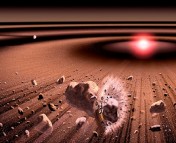- Title: The fast spin-rotation of a young extra-solar planet
- Authors: Ignas A. G. Snellen, Bernhard R. Brandl, Remco J. de Kok, Matteo Brogi, Jayne Birkby, and Henriette Schwarz
- First author’s institution: Leiden Observatory, The Netherlands
- Status: Published in Nature

Fig. 1: Composite image of the β Pic disk (observed with ADONIS on ESO’s 3.6 m telescope) and the planet β Pic b (observed with VLT/NACO). Image Credit: ESO/A.-M. Lagrange et al.
Planets spin because they have angular momentum left over from their formation. We’ve measured the rotational velocities of all the planets in the Solar System and it turns out that more massive planets spin faster. All the Solar System planets show a clear relationship between rotational speed and mass, except for Mercury and Venus which have slowed down due to tidal interactions with the Sun. Even Uranus fits this relationship, even though its spin axis is perpendicular to the rest of the Solar System. We don’t know exactly why there is a relationship between rotational speed and mass, but it probably has to do with the way mass is accreted during planet formation. The spin velocities of a few brown dwarfs have also been measured, but they show a larger spread in rotational speed for a given mass (see Fig. 3).
But what about planets in other systems? Is the spin-mass relationship unique to our Solar System? The authors of this paper investigated these questions by measuring the rotational velocity of an exoplanet (β Pictoris b) for the first time. β Pic is an interesting system for a lot of reasons: it’s bright and nearby, and has a huge debris disk oriented edge-on. The planet, β Pic b, was first observed directly in 2009.

Fig. 2: The solid line shows the measured signal from β Pic b, blueshifted by its orbit. The dotted line shows the signal that would be detected by a non-rotating planet on the same orbit. (Fig. 1b in the paper)
The authors of this paper observed β Pic b with the Cryogenic high-Resolution InfraRed Echelle Spectrograph (CRIRES), a very high-resolution spectrograph on the Very Large Telescope (VLT) at the European Southern Observatory (ESO). They observed the spectra of the planet and star simultaneously, then removed the contribution from the star using a reference spectrum. Subtracting the star’s spectrum was made easier by the fact that the planet is relatively far from the star and that the spectrum of the A-type star is fairly different from a planetary spectrum.
They were looking for the carbon monoxide (CO) absorption line around 2.3 µm in the planet’s spectrum. Any CO in the planet’s atmosphere would absorb light at this wavelength, leaving a dip in the spectrum. They detected this absorption line and found that it was Doppler shifted towards blue wavelengths, indicating that the planet is moving towards us as it orbits the star. Fig. 2 shows the cross-correlation signal (effectively, the detection level of the CO absorption line) versus velocity along our line-of-sight. They measured the blueshift and calculated that the planet is moving towards us relative to its star at about 15.4 km/s. This fits well with what we already know about the planet’s orbit from previous observations.
The authors also noticed that the absorption line is broadened, indicating that the planet is spinning. As the planet rotates, one side moves towards us as the other side moves away from us. The light from the side moving towards us is very slightly blueshifted, while the light from the hemisphere moving away from us is very slightly redshifted. This extra Doppler shifting broadens the observed absorption signal and allowed the authors to calculate that the equatorial rotation velocity of the planet is 25 km/s. This is really fast! If the radius of β Pic b is 1.65 times the radius of Jupiter, as predicted by previous spectral modeling, then the length of a day on β Pic b is only about 8 hours.

Fig. 3: Rotational velocity vs. mass for all Solar System planets (except Mercury and Venus) and β Pic b. The open circles are previously-measured brown dwarfs. (Fig. 2b in the paper)
The authors used previous estimates of β Pic b’s mass to place β Pic b on the rotational speed-mass plot with the Solar System planets (Fig. 3). They discovered that β Pic b fits well with the rest of the Solar System planets. This is reassuring, because it indicates that the same physics that caused the spin-mass relationship in the Solar System are also at work in the β Pictoris system. This could help us improve our understanding of the planet formation process. This paper also paves the way for future measurements of the rotational velocities of other exoplanets!





Trackbacks/Pingbacks